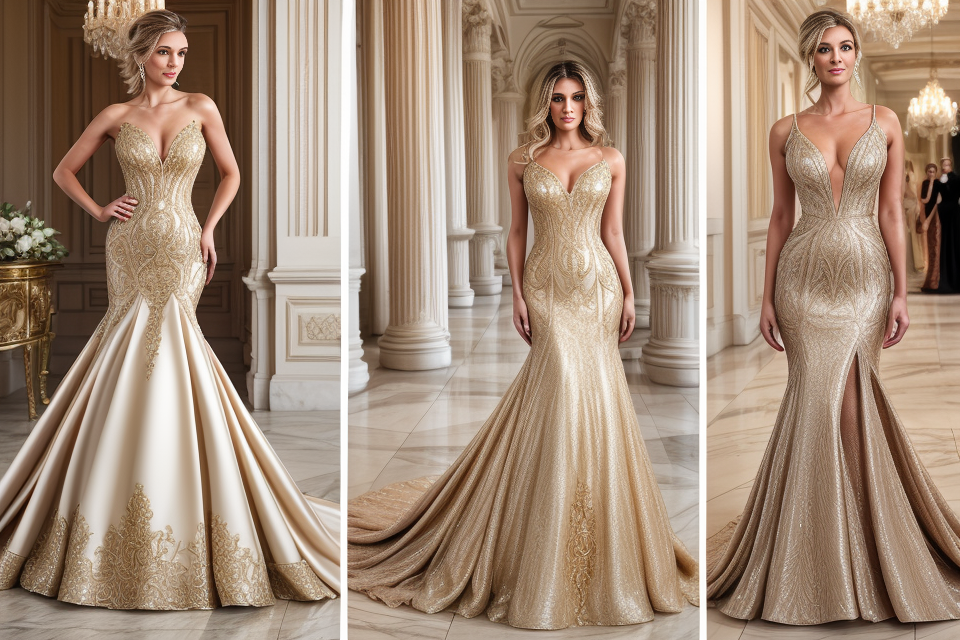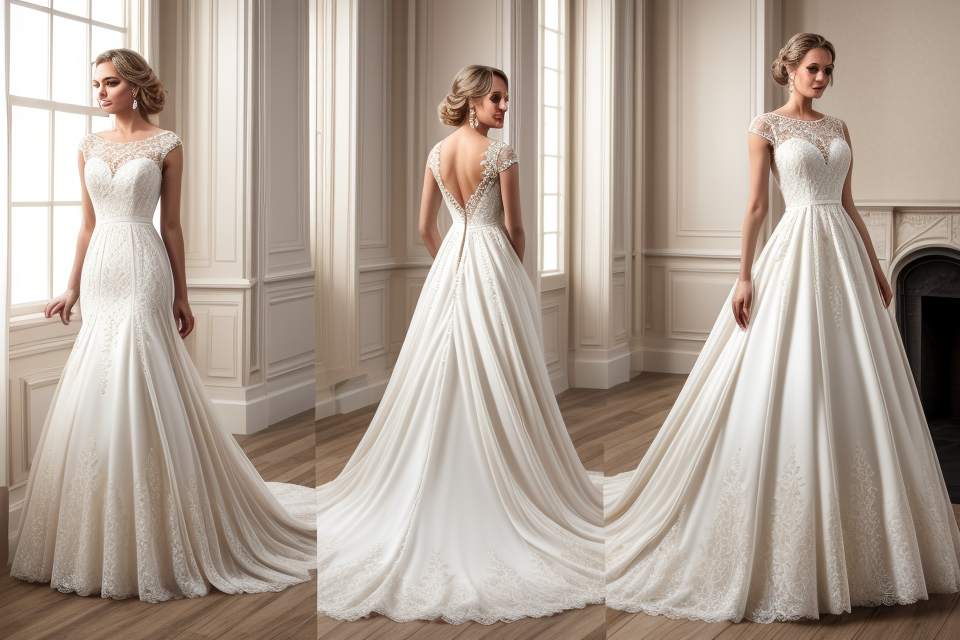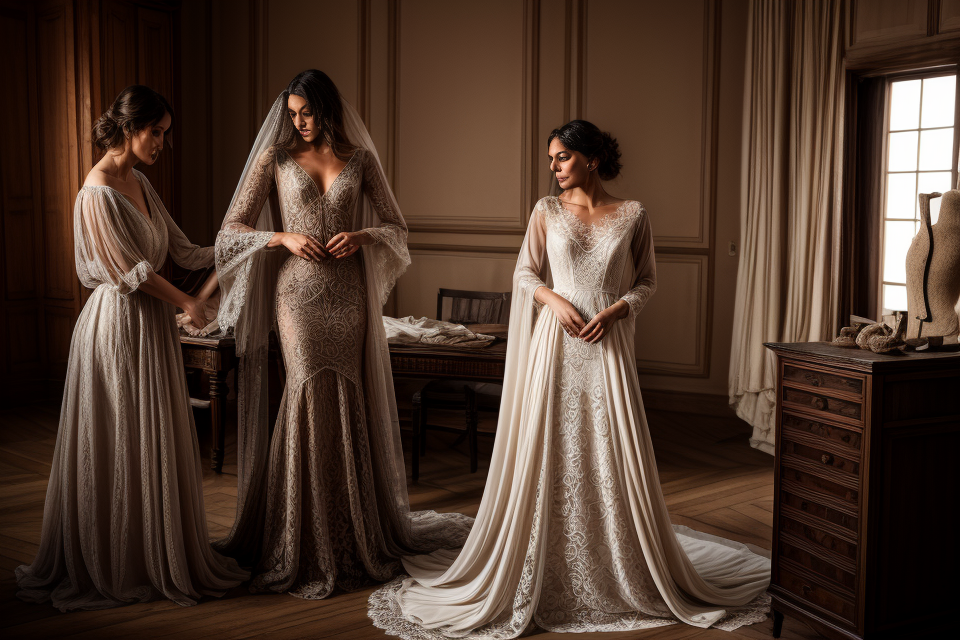
Gowns and dresses are two types of garments that are often used interchangeably, but they are actually quite different. A gown is a formal, long, and loose-fitting robe that is typically worn as part of a uniform or for special occasions. On the other hand, a dress is a garment that is typically worn by women and is usually more fitted and fashionable. In this comprehensive guide, we will explore the key differences between gowns and dresses, including their history, design, and usage. So, let’s dive in and discover what makes a gown different from a dress!
What is a Gown?
A gown is a long, flowing garment that is typically worn as formal attire for special occasions such as weddings, proms, and other formal events. Gowns are often characterized by their elegance, luxury, and sophistication, and are often made from luxurious fabrics such as silk, satin, and velvet.
History of Gowns
Gowns have a rich history dating back to ancient times, where they were often worn by royalty, nobility, and other high-ranking individuals as a symbol of status and power. Over time, gowns evolved to become more ornate and elaborate, with intricate designs, embellishments, and accessories. Today, gowns continue to be an important part of formal wear, with new styles and designs constantly emerging to reflect the changing fashion trends and cultural influences.
Parts of a Gown
A typical gown is composed of several parts, including a bodice, skirt, sleeves, and train. The bodice is the upper part of the gown, which fits closely to the body and is often laced or buttoned up the front. The skirt is the lower part of the gown, which flows out from the waist and is typically made from a fuller fabric than the bodice. The sleeves are attached to the bodice and are often long and flowing, with a split at the wrist to allow for ease of movement. The train is the long, flowing piece of fabric at the back of the gown, which is often designed to sweep the floor as the wearer moves.
Gown vs. Robe
While gowns and robes are both long, flowing garments, there are some key differences between the two. A gown is typically worn as formal attire for special occasions, while a robe is a more casual, everyday garment that is often worn at home or in a spa setting. Gowns are also generally more ornate and elaborate than robes, with more intricate designs, embellishments, and accessories. Additionally, gowns are typically closed at the front with laces, buttons, or other fasteners, while robes are often secured with a belt or tie.
What is a Dress?
Definition of a Dress
A dress is a one-piece garment that covers the entire body from the top of the head to the feet. It is typically worn by women for various occasions, such as weddings, parties, or special events. Dresses can be worn with different types of footwear, such as heels, flats, or sandals, and can be dressed up or down depending on the occasion.
Variations in Length and Style
Dresses come in various lengths, styles, and fabrics. Some common types of dresses include maxi dresses, mini dresses, midi dresses, sheath dresses, shift dresses, and wrap dresses. Each type of dress has its own unique features and is suitable for different occasions. For example, maxi dresses are typically long and flowing, making them ideal for outdoor weddings or summer festivals. Midi dresses are longer than mini dresses but shorter than maxi dresses, making them perfect for semi-formal events.
Function and Fashion
While dresses are primarily worn for fashion purposes, they also serve a functional purpose. They are often designed to flatter the figure and make the wearer look more stylish and put-together. In addition, dresses can be used to convey different messages and express different styles, from elegant and formal to casual and playful.
Types of Dresses
Dresses can be categorized into various types based on their design, fabric, and intended use. Some common types of dresses include:
- Evening dresses: These are formal dresses worn to evening events, such as galas, weddings, or award ceremonies.
- Day dresses: These are casual dresses worn during the day, such as to work or to run errands.
- Bridal dresses: These are special dresses worn by brides on their wedding day.
- Party dresses: These are dresses worn to parties, such as birthdays, anniversaries, or holiday parties.
- Cocktail dresses: These are semi-formal dresses that are suitable for cocktail parties or other semi-formal events.
- Athletic dresses: These are dresses designed for athletic activities, such as tennis or golf.
Overall, dresses are a versatile and essential part of a woman’s wardrobe, suitable for a wide range of occasions and styles. Whether it’s a formal evening gown or a casual sundress, dresses can be dressed up or down to suit any occasion.
Key Differences Between Gowns and Dresses
Length
One of the most obvious differences between gowns and dresses is their length. Gowns are typically much longer than dresses, reaching the floor or almost down to the ankles. They are often designed to be floor-length or chapel-length, which means they are suitable for formal occasions such as weddings, proms, and other black-tie events. On the other hand, dresses can be of various lengths, ranging from above the knee to full-length. They are generally more versatile and can be worn to different types of events, including casual gatherings and office settings.
Style
Another difference between gowns and dresses is their style. Gowns are often more elaborate and ornate, with intricate designs, embellishments, and details. They may have high necklines, long sleeves, and closed fronts, such as buttons or zippers. Gowns are often designed to create a dramatic and elegant look, making them perfect for formal events. In contrast, dresses are generally more simple and relaxed in style. They may have lower necklines, shorter sleeves, and open backs, showcasing a more casual and comfortable look. Dresses can vary from flowy and bohemian to structured and tailored, depending on the occasion and personal style.
Occasion
The occasion or event for which the garment is intended also plays a role in differentiating gowns from dresses. Gowns are typically reserved for formal and special occasions, such as weddings, galas, and award ceremonies. They are often made of luxurious fabrics, such as satin, silk, or chiffon, and adorned with beads, sequins, or lace. In contrast, dresses can be worn for a variety of occasions, ranging from casual outings to more formal events, such as office parties or cocktail parties. They may be made of different fabrics, such as cotton, denim, or jersey, and designed in various styles, from casual to formal.
Purpose
Lastly, the purpose of the garment can also differentiate gowns from dresses. Gowns are often designed to create a statement look and make the wearer feel elegant and sophisticated. They are often worn to show respect, admiration, or appreciation for a particular occasion or person. For example, graduation gowns are worn to signify the achievement of a degree, while judge’s robes are worn to symbolize the authority and impartiality of the legal system. In contrast, dresses are often worn for practical purposes, such as comfort, convenience, or functionality. They may be designed to suit a particular activity or function, such as hiking, swimming, or breastfeeding.
When to Wear a Gown
Formal Events
A gown is typically worn to formal events such as galas, balls, and award ceremonies. These events often have a specific dress code that requires guests to wear formal attire, and a gown is the perfect choice for such occasions.
Weddings
Weddings are another occasion where a gown is often worn. Brides typically wear a wedding gown, which is a formal dress specifically designed for the occasion. The wedding gown is usually white and is often decorated with lace, beads, and other embellishments. The bride may also choose to wear a veil and other accessories to complete her look.
Special Occasions
A gown can also be worn to special occasions such as graduations, religious ceremonies, and important business events. These occasions often require formal attire, and a gown is a great choice for making a statement and standing out in a crowd.
When choosing a gown to wear to a formal event, it’s important to consider the occasion, the dress code, and the overall atmosphere of the event. A gown should be chosen that is appropriate for the occasion and that makes the wearer feel confident and comfortable. With the right gown, any formal event can be a memorable and stylish experience.
When to Wear a Dress
Casual Events
When it comes to casual events, dresses can be a great option. They can be dressed up or down depending on the occasion. For a picnic in the park, a sundress paired with sandals and a wide-brimmed hat is perfect. A cocktail dress paired with heels and a clutch is perfect for a casual summer wedding or a backyard barbecue.
Work
Dresses can also be appropriate for the workplace, depending on the industry and company culture. For a more formal workplace, a suit dress or a dress with a blazer is appropriate for business meetings or presentations. For a more casual workplace, a nice blouse and a skirt or a casual dress can be appropriate for a typical workday.
Everyday Wear
Dresses can also be worn as everyday wear. A nice dress can be paired with boots and a cardigan for a casual outfit. For a more formal everyday look, a dress can be paired with heels and a blazer for a work-appropriate outfit.
In summary, dresses can be worn to a variety of events and occasions, including casual events, work, and everyday wear. They can be dressed up or down depending on the occasion and can be paired with a variety of accessories to create a complete outfit.
How to Choose Between a Gown and a Dress
Body Type
When choosing between a gown and a dress, it is important to consider your body type. A gown typically covers more of your body, including your arms, while a dress typically ends at your mid-calf or knee. A gown can be a more flattering choice for those with hourglass or pear-shaped figures, as it can create the illusion of a more defined waistline. On the other hand, a dress can be a more flattering choice for those with apple-shaped figures, as it can elongate the legs and create the illusion of a more defined waistline.
The occasion of the event is also an important factor to consider when choosing between a gown and a dress. A gown is typically more formal and is often worn to events such as weddings, galas, and formal dinners. A dress, on the other hand, can be worn to a variety of events, including casual gatherings, parties, and even some formal events.
Personal Preference
Ultimately, the most important factor to consider when choosing between a gown and a dress is your personal preference. Do you feel more comfortable and confident in a gown or a dress? Do you prefer the look and feel of one over the other? It is important to choose the option that makes you feel your best and most confident, regardless of the occasion or your body type.
Final Thoughts
When it comes to choosing between a gown and a dress, it’s important to consider the occasion, your personal style, and the dress code. Here are some final thoughts to keep in mind when making your decision:
- Consider the occasion: The occasion of the event can play a big role in determining whether you should choose a gown or a dress. For example, a formal wedding may require a gown, while a casual summer barbecue may call for a dress.
- Think about your personal style: Your personal style can also influence your decision. If you prefer more structured and formal clothing, a gown may be a better choice. If you prefer a more flowy and comfortable look, a dress may be a better fit.
- Pay attention to the dress code: The dress code of the event can also provide guidance on whether to choose a gown or a dress. If the dress code is specific, such as “black tie” or “cocktail attire,” it’s important to follow it accordingly.
Ultimately, the decision between a gown and a dress should be based on your personal preferences and the specific event you’re attending. With these final thoughts in mind, you can make an informed decision that will have you looking and feeling your best.
FAQs
1. What is the difference between a gown and a dress?
A gown and a dress are both types of clothing that are worn by women, but they differ in their design, style, and purpose. A gown is typically a more formal and elaborate garment that is worn on special occasions such as weddings, graduations, or formal events. It is often floor-length and has a closed front, such as a buttoned or lace-up closure. In contrast, a dress is a simpler and more casual garment that can be worn on a daily basis or for less formal occasions. It usually has a shorter length and a more open design, such as a hemline or a halter neck.
2. What are the characteristics of a gown?
A gown typically has several characteristics that distinguish it from a dress. Firstly, it is usually a more formal and elaborate garment, with a closed front and a long, flowing design. It may have a hood or cape, and it may be adorned with lace, beading, or other decorative elements. A gown may also have a train, which is a long piece of fabric that trails behind the wearer. It is often worn with formal accessories such as high heels, gloves, and a formal coat or shawl.
3. What are the characteristics of a dress?
A dress typically has a simpler and more casual design than a gown. It usually has a shorter length and a more open design, such as a hemline or a halter neck. It may have sleeves or be sleeveless, and it may have a variety of necklines, such as a V-neck or a scoop neck. A dress may also have a belt or a waistband, and it may be made of a variety of fabrics, such as cotton, silk, or denim. It is often worn with more casual accessories such as sandals or sneakers.
4. When should I wear a gown?
A gown is typically worn on special occasions such as weddings, graduations, or formal events. It is a formal and elaborate garment that is designed to make the wearer look elegant and sophisticated. If you are attending a formal event and want to make a statement with your outfit, a gown may be the perfect choice. However, it is important to consider the dress code of the event and the occasion itself when choosing a gown.
5. When should I wear a dress?
A dress is a more casual and versatile garment that can be worn on a daily basis or for less formal occasions. It is a simple and elegant choice for a variety of events, such as a brunch with friends, a date, or a day at the office. If you want to look stylish and comfortable, a dress may be the perfect choice. However, it is important to consider the occasion and the dress code when choosing a dress.


